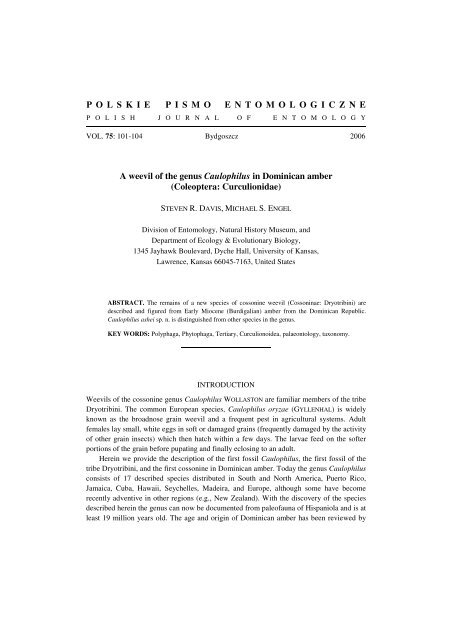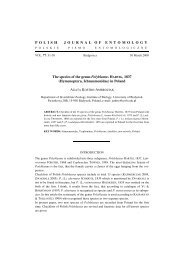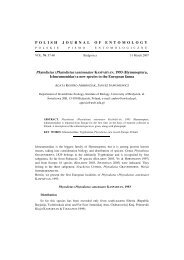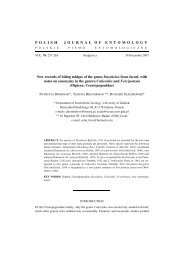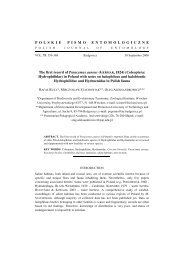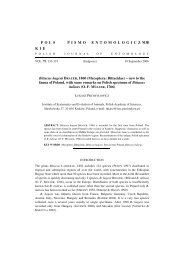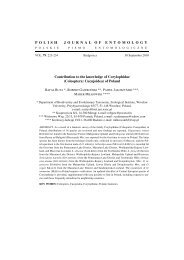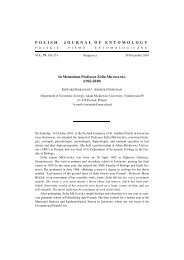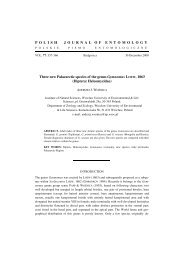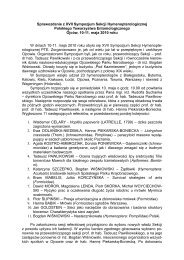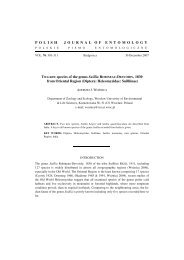DAVIS S. R., ENGEL M. S. A. weevil of the genus Caulophilus in ...
DAVIS S. R., ENGEL M. S. A. weevil of the genus Caulophilus in ...
DAVIS S. R., ENGEL M. S. A. weevil of the genus Caulophilus in ...
Create successful ePaper yourself
Turn your PDF publications into a flip-book with our unique Google optimized e-Paper software.
P O L S K I E P I S M O E N T O M O L O G I C Z N EP O L I S H J O U R N A L O F E N T O M O L O G YVOL. 75: 101-104 Bydgoszcz 2006A <strong>weevil</strong> <strong>of</strong> <strong>the</strong> <strong>genus</strong> <strong>Caulophilus</strong> <strong>in</strong> Dom<strong>in</strong>ican amber(Coleoptera: Curculionidae)STEVEN R. <strong>DAVIS</strong>, MICHAEL S. <strong>ENGEL</strong>Division <strong>of</strong> Entomology, Natural History Museum, andDepartment <strong>of</strong> Ecology & Evolutionary Biology,1345 Jayhawk Boulevard, Dyche Hall, University <strong>of</strong> Kansas,Lawrence, Kansas 66045-7163, United StatesABSTRACT. The rema<strong>in</strong>s <strong>of</strong> a new species <strong>of</strong> cosson<strong>in</strong>e <strong>weevil</strong> (Cosson<strong>in</strong>ae: Dryotrib<strong>in</strong>i) aredescribed and figured from Early Miocene (Burdigalian) amber from <strong>the</strong> Dom<strong>in</strong>ican Republic.<strong>Caulophilus</strong> ashei sp. n. is dist<strong>in</strong>guished from o<strong>the</strong>r species <strong>in</strong> <strong>the</strong> <strong>genus</strong>.KEY WORDS: Polyphaga, Phytophaga, Tertiary, Curculionoidea, palaeontology, taxonomy.INTRODUCTIONWeevils <strong>of</strong> <strong>the</strong> cosson<strong>in</strong>e <strong>genus</strong> <strong>Caulophilus</strong> WOLLASTON are familiar members <strong>of</strong> <strong>the</strong> tribeDryotrib<strong>in</strong>i. The common European species, <strong>Caulophilus</strong> oryzae (GYLLENHAL) is widelyknown as <strong>the</strong> broadnose gra<strong>in</strong> <strong>weevil</strong> and a frequent pest <strong>in</strong> agricultural systems. Adultfemales lay small, white eggs <strong>in</strong> s<strong>of</strong>t or damaged gra<strong>in</strong>s (frequently damaged by <strong>the</strong> activity<strong>of</strong> o<strong>the</strong>r gra<strong>in</strong> <strong>in</strong>sects) which <strong>the</strong>n hatch with<strong>in</strong> a few days. The larvae feed on <strong>the</strong> s<strong>of</strong>terportions <strong>of</strong> <strong>the</strong> gra<strong>in</strong> before pupat<strong>in</strong>g and f<strong>in</strong>ally eclos<strong>in</strong>g to an adult.Here<strong>in</strong> we provide <strong>the</strong> description <strong>of</strong> <strong>the</strong> first fossil <strong>Caulophilus</strong>, <strong>the</strong> first fossil <strong>of</strong> <strong>the</strong>tribe Dryotrib<strong>in</strong>i, and <strong>the</strong> first cosson<strong>in</strong>e <strong>in</strong> Dom<strong>in</strong>ican amber. Today <strong>the</strong> <strong>genus</strong> <strong>Caulophilus</strong>consists <strong>of</strong> 17 described species distributed <strong>in</strong> South and North America, Puerto Rico,Jamaica, Cuba, Hawaii, Seychelles, Madeira, and Europe, although some have becomerecently adventive <strong>in</strong> o<strong>the</strong>r regions (e.g., New Zealand). With <strong>the</strong> discovery <strong>of</strong> <strong>the</strong> speciesdescribed here<strong>in</strong> <strong>the</strong> <strong>genus</strong> can now be documented from pale<strong>of</strong>auna <strong>of</strong> Hispaniola and is atleast 19 million years old. The age and orig<strong>in</strong> <strong>of</strong> Dom<strong>in</strong>ican amber has been reviewed by
102 Polskie Pismo Entomologiczne 75 (1)GRIMALDI (1994), ITTURALDE-VINENT & MACPHEE (1996), and GRIMALDI & <strong>ENGEL</strong>(2005), while <strong>the</strong> general geological history <strong>of</strong> <strong>the</strong> Curculionidae has been summarized byGRATSHEV & ZHERIKHIN (2003).AcknowledgementsPartial support for this study was provided by National Science Foundation (USA) grantEF-0341724 (to M.S.E.). This is contribution No. 3458 <strong>of</strong> <strong>the</strong> Division <strong>of</strong> Entomology,Natural History Museum and Biodiversity Research Centre, University <strong>of</strong> Kansas.SYSTEMATIC PALAEONTOLOGYFamily: Curculionidae LATREILLE 1802Subfamily: Cosson<strong>in</strong>ae SCHÖNHERR 1825Tribe: Dryotrib<strong>in</strong>i LECONTE In LECONTE & HORN 1876Genus: <strong>Caulophilus</strong> WOLLASTON 1854Diagnosis<strong>Caulophilus</strong> ashei sp. n.(Figs 1–3)The pronotal length and shape, <strong>in</strong> which <strong>the</strong> posterior widens relative <strong>the</strong> anterior, arecharacteristic. In addition, <strong>the</strong> ra<strong>the</strong>r abrupt, slight dilation <strong>of</strong> <strong>the</strong> apical half <strong>of</strong> <strong>the</strong> rostrumis notable <strong>of</strong> <strong>the</strong> new species.DescriptionTotal body length (<strong>in</strong>clud<strong>in</strong>g rostrum) ca. 2.0 mm; maximal width ca. 0.48 mm; elytrallength ca. 1.0 mm. Integument brown to light brown (as preserved; colour patterns, if everpresent, are not preserved) (Figs 1–3). Compound eyes subcircular; <strong>in</strong>terocular distanceslightly less than width <strong>of</strong> rostrum <strong>in</strong> basal half <strong>in</strong> dorsal view. Rostrum <strong>of</strong> approximatelyequal width across its length although widen<strong>in</strong>g slightly apical half <strong>in</strong> dorsal view.Antennal scrobe at midlength <strong>of</strong> rostrum and shallow; scape just reach<strong>in</strong>g marg<strong>in</strong> <strong>of</strong>compound eye; base <strong>of</strong> funicle narrow, gradually enlarg<strong>in</strong>g to club. Vertex glabrous.Pronotum glabrous, length approximately slightly less than 1.5× width; anterior portionnarrower than posterior portion; small, shallow punctures present, punctures separated bydistance greater than or equal to puncture diameter; punctures fewer along posterior, medialhalf; median car<strong>in</strong>a absent; lateral car<strong>in</strong>a absent. Prosternum with shallow depressionbetween procoxae. Elytra each with approximately seven striae; punctures <strong>of</strong> elytral striaesmall, separated by distance <strong>of</strong> approximately 3× puncture diameter; humeri subquadrate.H<strong>in</strong>d w<strong>in</strong>gs well developed (evidenced by h<strong>in</strong>d w<strong>in</strong>g extend<strong>in</strong>g from beneath elytra <strong>in</strong>paratype (Fig. 1). Procoxa enlarged relative to meso- and metacoxae; meso- and metatibiae
<strong>DAVIS</strong> S.R. & <strong>ENGEL</strong> M.S.: A <strong>weevil</strong> <strong>of</strong> <strong>the</strong> <strong>genus</strong> <strong>Caulophilus</strong> <strong>in</strong> Dom<strong>in</strong>ican amber… 103laterally expanded apically; apical tibial unci at outer angle, large, approximately equal <strong>in</strong>length to tarsomere IV; a smaller denticle present on opposite side <strong>of</strong> uncus on <strong>in</strong>ner angle.HolotypeHolotype depicted <strong>in</strong> figures 2-3, AMNH DR-10-809, Early Miocene (Burdigalian)amber from <strong>the</strong> Dom<strong>in</strong>ican Republic, specific m<strong>in</strong>e unknown. The holotype is <strong>in</strong> <strong>the</strong> amberfossil collection, Division <strong>of</strong> Invertebrate Zoology, American Museum <strong>of</strong> Natural History,New York.ParatypesOne paratype depicted <strong>in</strong> figure 1, AMNH DR-10-568, Early Miocene (Burdigalian)amber from <strong>the</strong> La Toca m<strong>in</strong>e <strong>of</strong> <strong>the</strong> Dom<strong>in</strong>ican Republic; a second paratype is AMNH DR-15-272, from an unspecified m<strong>in</strong>e. The paratypes are <strong>in</strong> <strong>the</strong> same collection as <strong>the</strong> holotype.Figs 1-3. <strong>Caulophilus</strong> ashei sp. n. 1 – dorsal aspect <strong>of</strong> paratype (AMNH DR-10-568), 2 – dorsalaspect <strong>of</strong> holotype (AMNH DR-10-809), 3 – ventral aspect <strong>of</strong> holotype (AMNH DR-10-809).
104 Polskie Pismo Entomologiczne 75 (1)EtymologyThe specific epi<strong>the</strong>t is a patronymic honour<strong>in</strong>g <strong>the</strong> late Pr<strong>of</strong>. Dr. James S. ASHE (1947–2005), colleague and em<strong>in</strong>ent coleopterist.CommentsThis species is confidently placed <strong>in</strong> <strong>the</strong> extant <strong>genus</strong> <strong>Caulophilus</strong> based on <strong>the</strong>distance separat<strong>in</strong>g <strong>the</strong> procoxae, <strong>the</strong> distance <strong>of</strong> <strong>the</strong> procoxae from <strong>the</strong> posterior marg<strong>in</strong> <strong>of</strong><strong>the</strong> prosternum, <strong>the</strong> <strong>in</strong>sertion <strong>of</strong> <strong>the</strong> antennae at mid-length along <strong>the</strong> rostrum, and <strong>the</strong> slightapical expansion <strong>of</strong> <strong>the</strong> meso- and metatibiae. The rostrum, although more or less equal <strong>in</strong>width, expands slightly along <strong>the</strong> apical half and can be particularly confused with <strong>the</strong>genera Cossonus and Elassoptes. This expansion is more pronounced <strong>in</strong> Elassoptes andCossonus, however, and <strong>the</strong> antennal scrobe is partially visible <strong>in</strong> dorsal view, whereas <strong>in</strong><strong>Caulophilus</strong> <strong>the</strong> scrobe is not visible <strong>in</strong> dorsal aspect.O<strong>the</strong>r diagnostic features <strong>of</strong> <strong>Caulophilus</strong> exhibited by <strong>the</strong> fossil <strong>in</strong>clude: length lessthan 5.0 mm; body subcyl<strong>in</strong>drical and dorsoventrally compressed; <strong>in</strong>tegument brown tolight brown and glabrous; antennal <strong>in</strong>sertion at approximately mid-length <strong>of</strong> rostrum;antennae geniculate, composed <strong>of</strong> seven funicular articles; elytra approximately 2x length<strong>of</strong> pronotum or slightly less; procoxae separated by slightly less than diameter <strong>of</strong> an<strong>in</strong>dividual coxa, situated distantly from posterior marg<strong>in</strong> <strong>of</strong> prosternum, separated frommarg<strong>in</strong> by approximately a coxal diameter; tarsi tetramerous.REFERENCESGRATSHEV V.G., ZHERIKHIN V.V. 2003. The fossil record <strong>of</strong> <strong>weevil</strong>s and related beetle families(Coleoptera, Curculionoidea). Acta Zoologica Cracoviensia 46(suppl.): 129–138.GRIMALDI D. 1994. The age <strong>of</strong> Dom<strong>in</strong>ican amber. In: ANDERSON K.B., CRELLING J.C. (eds.). Amber,Res<strong>in</strong>ite, and Fossil Res<strong>in</strong>s: 203–217. American Chemical Society; Wash<strong>in</strong>gton, D.C.; xvii + 297 pp.GRIMALDI D., <strong>ENGEL</strong> M.S. 2005. Evolution <strong>of</strong> <strong>the</strong> Insects. Cambridge University Press; Cambridge,United K<strong>in</strong>gdom, xv + 755 pp.ITURRALDE-VINENT M.A., MACPHEE R.D.E. 1996. Age and paleogeographical orig<strong>in</strong> <strong>of</strong> Dom<strong>in</strong>icanamber. Science 273(5283): 1850–1852.LATREILLE P.A. 1802. Histoire Naturelle, Générale et Particulière des Crustacés et des Insectes.Ouvrage faisant suite à l’histoire naturelle générale et particulière, composée par Leclerc deBuffon, et rédigée par C.S. Sonn<strong>in</strong>i, membre de plusiers sociétés savantes. Tome troisième.Dufart; Paris, France; xii + 467 pp.LECONTE J.L., HORN G.H. 1876. The Rhynchophora <strong>of</strong> America north <strong>of</strong> Mexico. Proceed<strong>in</strong>gs <strong>of</strong> <strong>the</strong>American Philosophical Society 15(96): xvi + 1–455.SCHÖNHERR C.J. 1825. Cont<strong>in</strong>uatio Tabulae synopticae Familiae Curculionidum. Isis, Oken 1825(5):581–588 [columns].WOLLASTON T.V. 1854. Insecta Maderensia; be<strong>in</strong>g an account <strong>of</strong> <strong>the</strong> <strong>in</strong>sects <strong>of</strong> <strong>the</strong> islands <strong>of</strong> <strong>the</strong>Madeiran group. London, United K<strong>in</strong>gdom, xliii + 634 pp.Received: January 24, 2005Accepted: February 18, 2006


